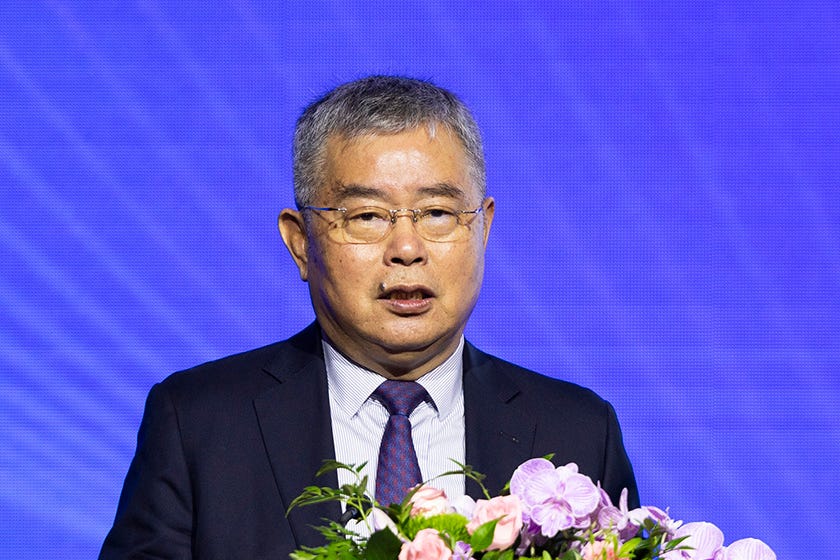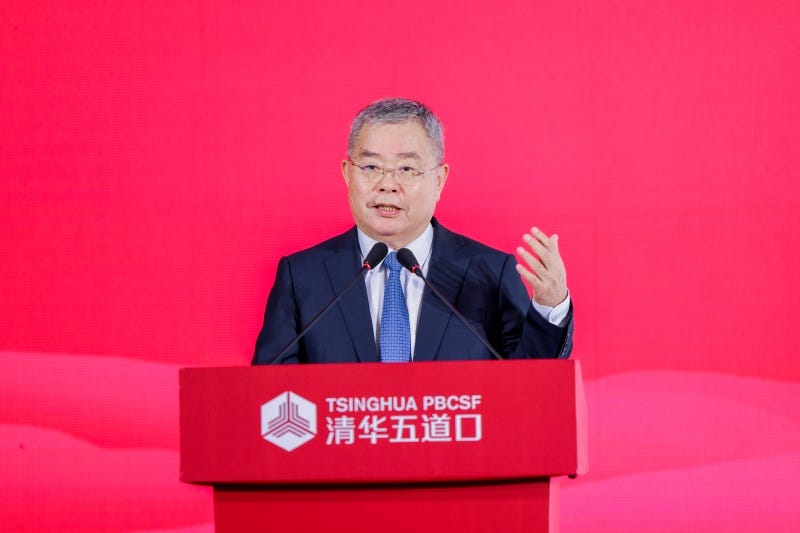Li Yang on stablecoins
CASS economist advocates steadfast internationalisation of the renminbi while utilising Hong Kong’s offshore market to develop renminbi stablecoins.
Stablecoins—digital tokens pegged to traditional currencies—have been gaining traction worldwide. In Washington, lawmakers are heading toward a regulatory framework, while in Hong Kong, the recent passage of the Stablecoins Bill has stirred interest across the mainland financial market. In light of this, we will be publishing a series of articles to explore the ongoing discussions surrounding stablecoins in China.
Li Yang is an Academician of the Chinese Academy of Social Sciences (CASS), the ministerial-level government think tank where the title Academician, 学部委员 in Chinese, is only granted to the most recognised social scientist.
Presiding over the National Institution for Finance & Development (NFID), formerly the CASS Financial Laboratory, Li Yang was previously a Vice President of CASS, equivalent to a vice minister in the central government. In 2015, the NIFD and 25 other institutes were highlighted as the first batch of “state high-end think tanks,” where it is the only one specialising in finance.
Amid renewed debate in China over the future of digital currency and the prospect of a renminbi-denominated stablecoin, Li delivered the following speech on June 17 at the China Securities 2025 Mid-Year Capital Markets Investment Summit.
The Chinese transcript remains accessible on the NFID’s official website and official WeChat blog.
李扬:面对稳定币浪潮,中国需双轨并进
Li Yang: China Must Advance on Dual Tracks in Response to the Stablecoin Wave
Recent market discussions on stablecoin legislation have highlighted the pivotal role stablecoins play in the contemporary international monetary and financial landscape. Their nature, impact, and relationship with sovereign currencies urgently require clarification.
The core value of stablecoins lies in their highly efficient payment and settlement functions. As blockchain-based peer-to-peer payment instruments, they enable instant settlement upon payment, offering significant advantages in transaction speed and cost efficiency, which are the fundamental, irreplaceable characteristics of currency.
Unlike volatile cryptocurrencies such as Bitcoin, stablecoins maintain value stability by pegging to real-world assets, primarily USD-denominated reserves. Leading stablecoins like USDT and USDC hold over 90% of their assets in short-term U.S. Treasury bonds and repurchase agreements. This mechanism positions stablecoins as a bridge between the cryptocurrency ecosystem and traditional fiat systems, substantially enhancing cross-border payment efficiency while reducing costs.
The U.S. promotion of stablecoin legislation is explicitly aimed at serving the interests of the U.S. dollar: modernising dollar payments, consolidating and strengthening the dollar’s international position, and creating trillions in new demand for U.S. Treasury bonds. The stablecoin mechanism ingeniously transforms the expansion of the cryptocurrency market into an extension of dollar influence on the blockchain.
When studying various so-called “coins,” it is essential to firmly remember one principle: as long as sovereign states exist, the sovereign nature of currency will not change. Monetary sovereignty is an important component of national sovereignty, representing each nation’s supreme power to issue and manage its domestic currency, as well as its fundamental right to independently implement international monetary policies and participate equally in international monetary and financial affairs. Therefore, the emergence of various digital assets, including stablecoins, does not signify the creation of any new international monetary system that transcends sovereignty.
Thus, no matter how stablecoins develop, when used for international payments, they cannot bypass the “foreign exchange” regulations between sovereign currencies.
However, given that payment and settlement constitute the most basic and irreplaceable function of currency, the continued expansion of stablecoin payment systems, while unable to create a new international currency, effectively erodes the functions of existing sovereign currencies. This poses a significant threat to existing national monetary systems and even the international monetary system, requiring focused preventive measures.
Therefore, in response to the stablecoin wave, China needs to advance on two parallel tracks.
On one hand, since no form of stablecoin can circumvent the issue of monetary sovereignty, resolutely advancing renminbi internationalisation remains the core task of cultivating a strong currency (the renminbi). In this sense, all the efforts China has made in the past—including expanding currency swap agreements, promoting the renminbi Cross-border Interbank Payment System (CIPS), improving the global renminbi clearing service network, and increasing the use of renminbi in investment and trade among Belt and Road countries—should be steadfastly continued.
On the other hand, it must be recognised that the trend of integration between stablecoins, cryptocurrencies, and the traditional financial system will be difficult to reverse. Stablecoins and cryptocurrencies will complement central bank digital currencies (CBDCs), comprehensively improving payment efficiency, reducing costs, restructuring the global payment system, and driving the development of decentralised finance (DeFi). Although in previous years, some countries supported only CBDC experiments while others focused on fostering innovation in stablecoins and cryptocurrencies, most have recently shifted toward a model that supports the coordinated development of all three. The EU, Japan, the UAE, Singapore, and Hong Kong, China, are typical examples of supporting this integrated approach.
Of course, in advancing the development of stablecoins, issues such as the substitution of sovereign currencies, money laundering, user rights protection, and loss of monetary policy control must also be properly addressed.
Regarding future development pathways, China should fully leverage Hong Kong’s advantageous position as a financial centre and existing institutional foundations (such as USDT’s headquarters being located there) to develop offshore renminbi stablecoins and establish controlled international payment channels. In other words, China should create a yuan-linked stablecoin issued and circulated outside of the Chinese mainland.
In fact, as early as 2019, Tether, the world’s largest stablecoin issuer, launched an offshore renminbi stablecoin, which now has a circulation exceeding 20 million yuan. Conditions should also be created to actively and prudently advance the development of renminbi stablecoins by leveraging Shanghai’s status as an international financial centre.
Stablecoins are not a new independent currency, but rather represent a technological upgrade and extension of the dollar system in the digital age. Their rise highlights the central importance of payment and settlement functions and the critical role of account systems. The global competition to legislate and regulate stablecoins reflects attempts to control this crucial nexus linking the virtual and real economies.
For China, the fundamental approach to navigating these changes and safeguarding monetary and financial security lies in strengthening economic fundamentals, consolidating the foundation of sovereign currency, effectively utilising Hong Kong’s offshore market to develop renminbi stablecoins, and pragmatically advancing the internationalisation of the renminbi.
Li Yang's financial diagnosis of China's economy
Li Yang is an Academician of the Chinese Academy of Social Sciences (CASS), the ministerial-level government thinktank where the title Academician, 学部委员 in Chinese, is only granted to the most recognized social scientist.






It’s an important discussion to be having. That said, the question is: in what ways are stablecoins of use, to whom and under what circumstances? As fiat currency derivatives, they do not add to aggregate money stock but provide a different mechanism for accounting for the exchange of value. The promise is faster, cheaper, more secure, more private. On each front, the claims cannot be accepted without qualification. Other technologies deliver fast and cheap too, with similar or better security properties. As for privacy, stablecoins have been a favourite for illicit uses but the KYC/AML regulatory noose will tighten. The risks include de-pegging and actually high costs. Add to the risks the under-provisioning of “dollar for dollar” security and the risk is that stablecoin holders cannot redeem for want of fiat liquidity on the part of the issuer.
Dollar-backed stablecoins are a geopolitical extension of U.S. financial power, exploiting gaps in global digital currency infrastructure to entrench the dollar’s role. Yet they cannot solve America’s own payments inefficiencies or replace a genuine digital USD. China, with the digital RMB and the prospect of a robust RMB bond market, holds the most credible strategy to challenge dollar supremacy in international finance—by offering partners a stable, low-cost alternative with deeper economic integration.